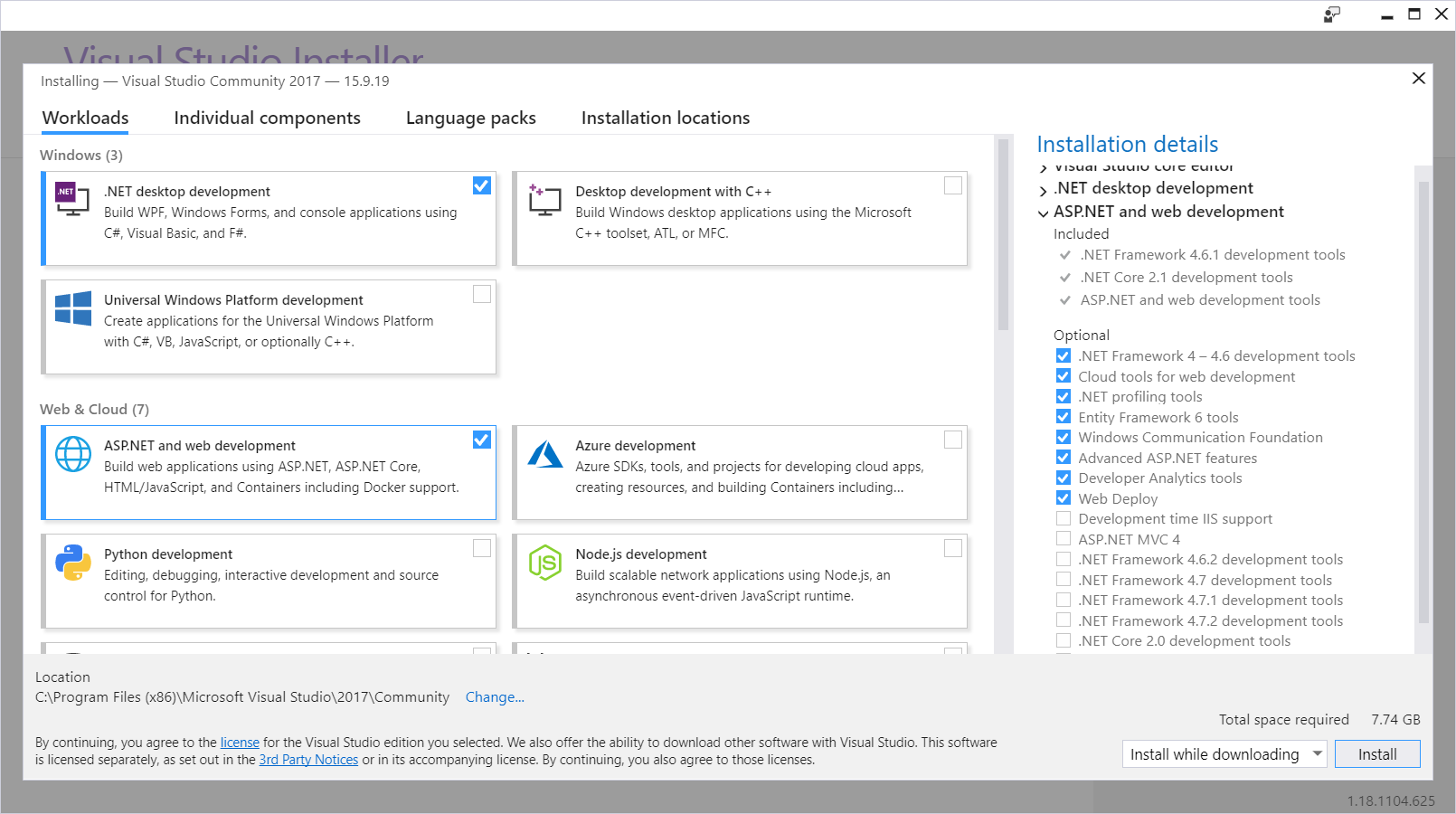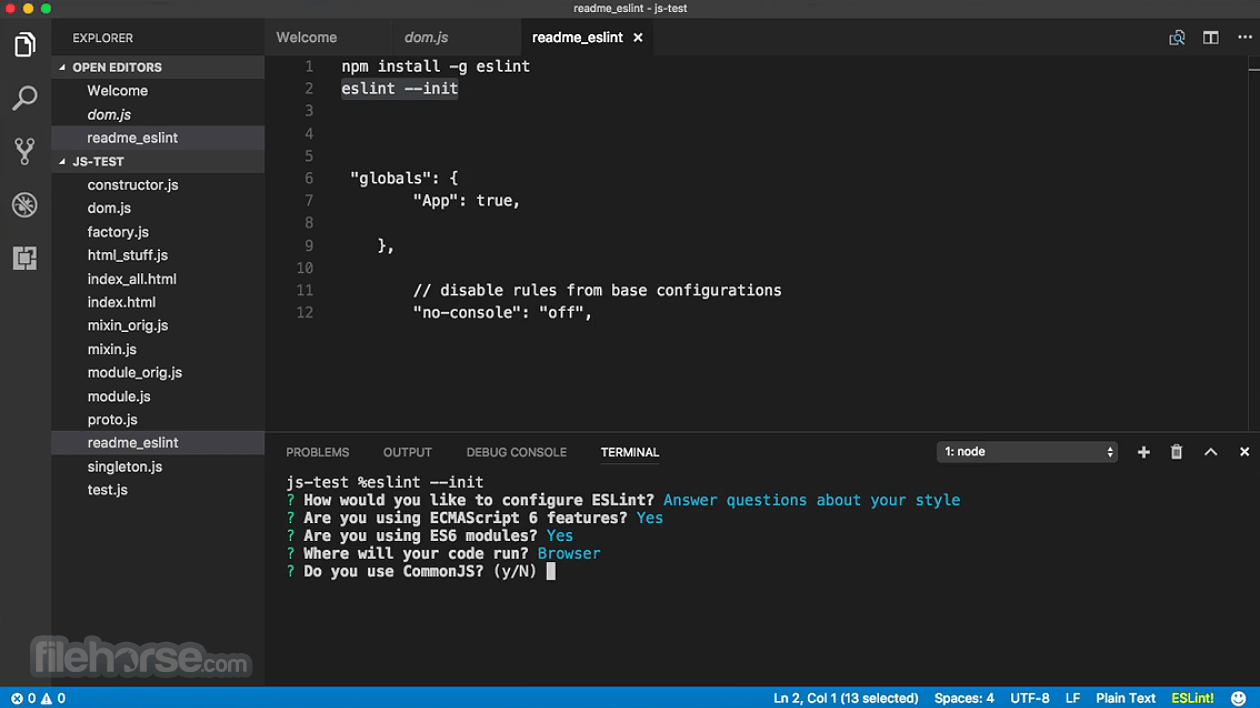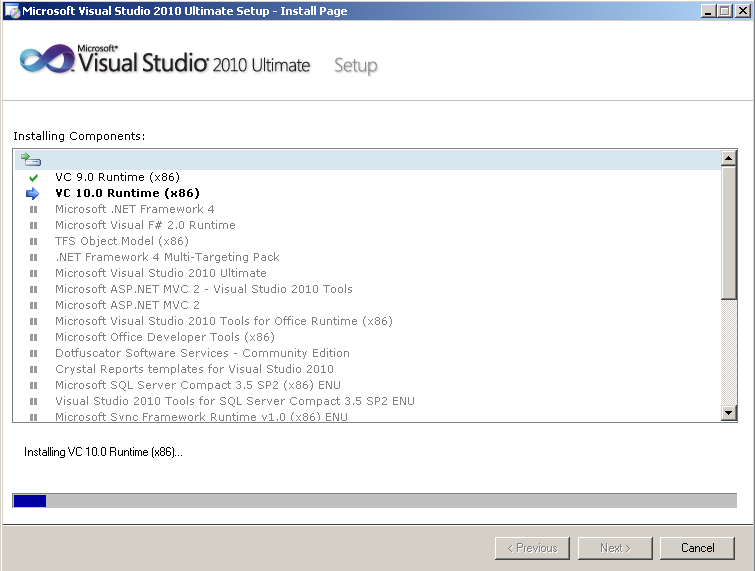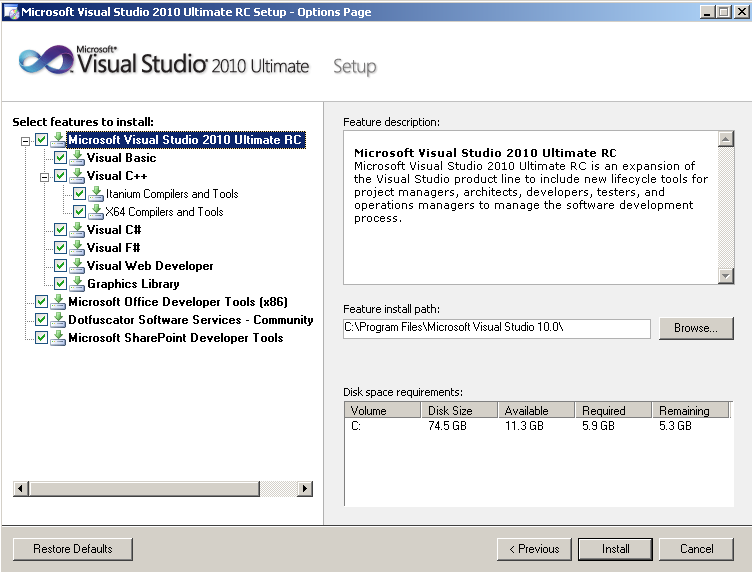
- Visual Studio 2010 Sp1 X64
- Visual Studio 2010 Sp1 Sdk
- Download Visual Studio 2010 Sp1
- Install Web Components Visual Studio 2010 Sp1 Online
- Visual Studio 2010 Sp2
The Visual C Redistributable Packages install run-time components of Visual C libraries. These components are required to run C applications that are developed using Visual Studio 2015 and link dynamically to Visual C libraries. These package can be used to run such applications on a computer even if it does not have Visual Studio 2015. Visual Studio 2010 Express is one of. Easily drag and drop documents to the IDE and start working, it helps in integrating components made written in.
Enable Internet Information Services
Microsoft Internet Information Services (IIS) provides a Web application infrastructure for many BizTalk Server features. BizTalk Server requires IIS for the following features:
HTTP adapter
SOAP adapter
Windows SharePoint Services adapter
Secure Sockets Layer (SSL) encryption
BAM Portal
1. Click Start and then click Control Panel. 2. In Control Panel, click Programs and then click Turn Windows features on or off. 3. In the Windows Features dialog box, click Internet Information Services. 4. Expand Internet Information Services. Additional categories of IIS features are displayed. Select Internet Information Services. 5. Expand Web Management Tools and then select IIS 6 Management Compatibility. 6. Expand World Wide Web Services, select Application Development Features, under Security, select Basic Authentication and Windows Authentication. Click Ok |
Important
The .NET Framework 4 can be installed side-by-side with previous versions of the .NET Framework on a single computer. If IIS was previously enabled on the computer, the setup process for the .NET Framework automatically registers ASP.NET 4 with IIS. However, if you install the .NET Framework 4 before you enable IIS, you must run the ASP.NET IIS Registration tool in order to register the .NET Framework with IIS and create application pools that use the .NET Framework 4. To manually register ASP.NET 4 with IIS, at the command prompt, type the following command and press Enter: %windir%Microsoft.NETFrameworkv4.0.30319aspnet_regiis.exe /i.
After registering ASP.NET 4, you must ensure that the restriction status of ASP.Net v4.0.30319 is set to Allowed. To check the registration status, follow these steps:

1. Open IIS Manager. In Features View, double-click ISAPI and CGI Restrictions.
2. The restriction status of ASP.Net v4.0.30319 should be set to Allowed. You can change the restriction status by selecting the restriction and clicking Allow or Deny in the Actions pane
3. Click Ok
Install Microsoft Office Excel 2010 or 2007
Microsoft Office Excel is required for using the Business Activity Monitoring (BAM) feature in BizTalk Server. You use the BAM Office Excel Workbook to define the business processes you want to monitor. You also use the BAM Excel Workbook to define the way in which business users see the data collected by BAM.
BizTalk Server 2010 supports only 32-bit version of Microsoft Office 2010.
The following procedure installs only Office Excel. You can install additional Microsoft Office system applications and tools if you wish, but they are not necessary to complete the installation of BizTalk Server.
Note
To successfully load BAM.xla into Excel, install the Visual Basic for Applications option under Office Shared Features. Otherwise, you may get the error “This workbook has lost its VBA project, ActiveX controls and any other programmability-related features.”
1. Insert the Microsoft Office installation disk into the DVD-ROM drive. 2. When you reach the Type of Installation screen, select Custom Install, and then click Next. 3. On the Custom Setup screen, ensure that Excel is selected, and then click Next. 4. Click Install. 5. On the Setup Completed screen, click Finish. |
Install Visual Studio 2010
The BizTalk Server development tools are based on Visual Studio 2010. Therefore, at a minimum, you must have the Microsoft Visual C#® .NET portion of Visual Studio 2010 installed on your computer before installing the BizTalk Server Developer Tools and SDK component.
Visual Studio 2010 is not required if you are installing BizTalk Server on a production computer (runtime only), on which no application development or debugging will occur.
The BizTalk Server runtime components require .Net Framework 4 and .NET Framework 3.5 SP1. In addition, the .NET Framework 3.0 is required if the Windows Communication Foundation (WCF) adapter or WCF Interceptor is installed.
Note

If you install Visual Studio and BizTalk Server, and then upgrade to Visual Studio Team Explorer, it may be necessary to repair your BizTalk Server installation by using Control Panel (View by: Large/Small icons) - Programs and Features.
1. Insert the Visual Studio 2010 installation disk into the DVD-ROM drive. 2. Click Install Visual Studio 2010. 3. After the installation loads, click Next. 4. On the Start page, accept the license agreement, type your Product Key and any other necessary information, and then click Next. 5. On the Options page, select Custom, and then click Next. 6. Under Select features to install, clear all features except Visual C#, and then click Install. Important Your version of Visual Studio may include Microsoft SQL Server Express as an optional feature. Do not install this feature, as it will cause BizTalk Server setup to fail. 7. On the Finish page, click Finish. 8. On the Visual Studio Setup screen, click Exit. |
Install SQL Server 2008 R2/ SP1
BizTalk Server provides the capability to specify a business process and also a mechanism by which the applications used in that business process can communicate with each other. SQL Server is the main repository for this communication mechanism. You must install SQL Server 2008 R2/2008 SP1 (Enterprise Edition is recommended).
BizTalk Server supports all case-sensitive and case-insensitive SQL Server collations except for binary collations. Binary collations are not supported.
Important
BAM real-time aggregation (RTA) is not supported in SQL Server 2008 R2/2008 SP1 Standard Edition. In order to use BAM RTA, you must install SQL Server 2008 R2/2008 SP1 Enterprise Edition.

1. Insert the SQL Server 2008 R2 installation disk into the DVD-ROM drive. The setup program will begin automatically. If prompted for automatic installation of prerequisite software, click OK. 2. On the SQL Server Installation Center, click Installation. 3. Click New Installation or Add Features to an Existing Installation. 4. Review the information on the Setup Support Rules screen, and then click OK. 5. On the Product Key screen, enter your product key and click Next. 6. On the License Terms screen, select I accept the license terms, and then click Next. 7. On the Setup Support Files screen, click Install. 8. On the Feature Selection screen, select the following features, and then click Next. Database Engine Services SQL Server Replication Full-Text Search Analysis Services Reporting Services Shared Features Business Intelligence Development Studio Client Tools Connectivity Integration Services Management Tools - Basic Management Tools - Complete 9. On the Instance Configuration screen, select Default instance, and then click Next. 10. Review the information on the Disk Space Requirements screen, and then click Next. 11. On the Server Configuration screen, click Use the same account for all SQL Server instances, enter a local account or domain account and password, and then click Next. 12. On the Database Engine Configuration screen, select Windows authentication mode, click Add Current User, and then click Next. 13. On the Analysis Services Configuration screen, click Add Current User, and then click Next. 14. On the Reporting Services Configuration screen, select Install the native mode default configuration, and then click Next. 15. On the Error and Usage Reporting screen, leave the default values, and then click Next. 16. On the Installation Rules screen, review the information and resolve any issues, and then click Next. 17. On the Ready to Install screen, review the information, and then click Install. 18. On the Installation Progress screen, after setup has finished, click Next. 19. On the Complete screen, click Close. |
Install Prerequisites for MQSeries Agent
If you plan to use the MQSeries Agent, you will need to download the following:
.Net Framework 4 (http://go.microsoft.com/fwlink/?LinkID=189318) and .Net Framework 3.5 SP1 (http://go.microsoft.com/fwlink/?linkid=160478).
You will also need to download one of the following:
IBM WebSphere MQ 5.3 with CSD 10 (or later), or
IBM WebSphere MQ 7.0
Caution
IBM WebSphere is not supported by Microsoft, and Microsoft makes no guarantees about the suitability of this program. Use of these programs is entirely at your own risk. For more information about these utilities, including download instructions, see the IBM Web site at www.ibm.com.
Finally, you must run the MQSAgent COM+ Configuration Wizard (MQSConfigWiz.exe) on the computer where MQSAgent is installed prior to using either the MQSeries Adapter or the Windows SharePoint Services Web service.
Install SQL Server 2005 Notification Services
If you plan to use BAM Alerts in your BizTalk Server project, you must install SQL Notification Services and its prerequisites on your BizTalk Server computer. This SQL Server 2005 feature is not included in SQL Server 2008 R2/2008 SP1, but you can install it from the Microsoft Download Center.
1. Click or navigate to the Feature Pack for Microsoft SQL Server 2005 - December 2008. 2. Depending on your platform, download the appropriate package from the following three components: Microsoft SQL Server Native Client X86 Package (sqlncli.msi) X64 Package (sqlncli_x64.msi) X86 Package (SQLServer2005_XMO.msi) X64 Package (SQLServer2005_XMO_x64.msi) X86 Package (SQLServer2005_NS.msi) X64 Package (SQLServer2005_NS_x64.msi) |
Disable the Shared Memory Protocol
Under certain stress conditions (such as clients accessing SQL Server from the same computer), the SQL Server Shared Memory protocol may lower BizTalk Server performance. You can resolve this problem by disabling the use of the Shared Memory network protocol in the SQL Server Client Network Utility.
To disable Shared Memory protocol for SQL Server 1. Click Start, point to All Programs, point to Microsoft SQL Server 2008 R2, click Configuration Tools, and then click SQL Server Configuration Manager. 2. In SQL Server Configuration Manager, expand SQL Server Network Configuration, and then click Protocols for MSSQLSERVER. 3. Right-click Shared Memory, and then click Disable. 4. Click SQL Server Services, right-click SQL Server (MSSQLSERVER), and then click Stop. After the service has stopped, right-click SQL Server (MSSQLSERVER) again, and then click Start. 5. Close SQL Server Configuration Manager. |
Join the Local Administrators Group
You must be an administrator to install and configure BizTalk Server 2010. Use this procedure to join the Administrators group on the local computer.
1. Click Start, click Control Panel, and then double-click User Accounts. 2. Click Manage User Accounts. 3. In the User Accounts dialog box, click the Advanced tab. 4. Under Advanced user management, click Advanced. 5. In the left-hand pane, click Groups. 6. In the right-hand pane, double-click Administrators. 7. In the Administrators Properties dialog box, look for your name in the Members list. 8. If your name is in the list, proceed to Step 9. If your name is not in the Members list, do the following: Click Add. In the Enter the object names to select box, type your name, and then click Check Names. Once your name is recognized, click OK. 9. Click OK to close the Administrators Properties dialog box, and then close the Local Users and Groups pane. 10. Click OK to close the User Accounts dialog box. 11. Close the Users Accounts pane. |
Configure the Application Event Log
BizTalk Server setup keeps a record of events in the Application Event Log. Depending on the BizTalk Server features installed, the amount of space required in the log may exceed its limit. If the application event log runs out of space during BizTalk Server setup, the installation will fail.
To prevent this from happening, you can change the settings in the Application Event Log.
Visual Studio 2010 Sp1 X64
To change settings in the Application Event Log 1. Click Start, click Control Panel (View by: Large/Small icons), and then double-click Administrative Tools. 2. Double-click Event Viewer. 3. In the Event Viewer, expand Windows Logs. 4. Right-click Application, and then click Properties. This opens the Log Properties dialog box. To see how much available space your log has, compare the Log Size field with the Maximum log size field. To provide more space in the event log, enter a higher number in the Maximum log size field. To enable overwriting of old events when the log becomes full, select Overwrite events as needed. To clear the log events, click Clear log. 5. Click OK, close the Event Viewer, and close Administrative Tools. |
download -> EVault Portal Version 80. 0207 Release Notes, June 18, 2015
download -> Naamsesteenweg 145, 3001 Heverlee
download -> -
download -> Lab Exercise: Installing xampp and Configuring it with PhpStorm
Visual Studio 2010 Sp1 Sdk
Two days after it offered it to MSDN subscribers, Microsoft released Visual Studio 2010 Service Pack 1 (SP1) RTM for all developers via the Download Center.The Microsoft Visual Studio 2010 Service Pack 1 (Installer) went live on the Download Center just two days after the upgrade was released to devs with MSDN subscriptions, as the Redmond company announced earlier this week.
” This web installer downloads and installs Visual Studio 2010 Service Pack 1. An Internet connection is required during installation,” Microsoft explained.
Devs running any edition of Visual Studio 2010, including Express, Professional, Premium, Ultimate, Test Professional , can leverage the SP1 RTM installer in order to upgrade their development platform.
Download Visual Studio 2010 Sp1
The software giant has made available a Readme containing information about known problems that customers might be coming across - a recommended read prior to the deployment of the service pack.
“Visual Studio 2010 Service Pack 1 (SP1) will upgrade all editions and languages of Visual Studio 2010 you have already installed. If you install any other editions or languages of Visual Studio 2010 after SP1, you must reapply SP1,” the company added.
There’s some good news for early adopters that have been testing Visual Studio 2010 SP1 Beta. According to the Redmond company, testers are not required to uninstall the Beta ahead of upgrading to SP1 RTM.
“This download installs Visual Studio 2010 Service Pack 1 (SP1). This service pack release addresses issues that were found through a combination of customer and partner feedback, as well as internal testing,” the company explained.
“These service packs offer Visual Studio users improvements in responsiveness and stability, as well as completes some high-impact scenarios requested by customers.”
Along with the Visual Studio 2010 SP1 Installer, Microsoft is also offering developers the service pack as an ISO image.
Install Web Components Visual Studio 2010 Sp1 Online

The ISO image of Visual Studio 2010 SP1 RTM is designed for customers that wish to upgrade offline machines or that want to distribute the upgrade via physical media.
Visual Studio 2010 Sp2
Visual Studio 2010 Service Pack 1 (SP1) RTM ISO and Installer are available for download here.